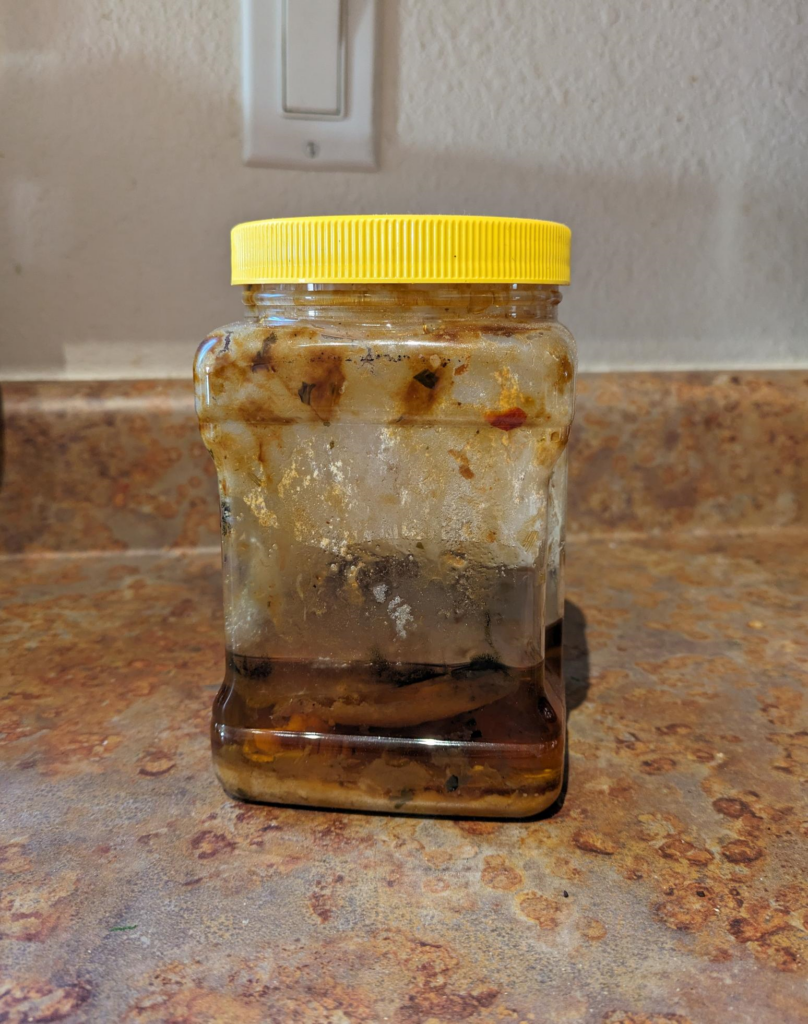Fats, Oils, and Grease (FOG) are a common problem in sewer systems that can cause serious issues for the public and individual homes. FOG results from the cleaning of dishes used to prepare, serve, and eat food or when these materials are dumped directly down the drain. When food is washed off dishes or if grease is disposed of directly into sinks, such as grease from cooking meats or old oil used in fryers, it typically enters home drains where FOG from that food can accumulate in home sewer pipes and the sewer system. These FOG deposits can clog sewer pipes as more and more FOG and other wastewater components accumulate. Clogs can lead to unsafe and unpleasant wastewater overflows. We are going to talk more in-depth about how FOG enters the sewer system, what happens when there is excessive FOG in sewers, and how to avoid putting unnecessary FOG down your drains.
Sources of FOG
When you prepare, serve, or eat food there is a very high chance that at least some of it will stick to the dishes you use. When these dishes are cleaned these food particles can end up in home pipes and the public sewer where they break down into FOG and other components. FOG can come from any type of food, but some types of food such as meats, dairy products, sauces, and foods cooked with lots of oils and grease tend to contribute more to sewer clogs than others. FOG in sewers often begins as a liquid, when it is heated during cooking and is easier to pour down drains. However, when liquid FOG is washed down the drain it begins to cool and will solidify in the pipes. This is why it is important to never pour hot oil and grease down the drain.
Impact of FOG
FOG is composed largely of lipids that have chemical properties that allow them to accumulate quickly and cause problems in household and commercial pipes and sewers. These molecules are hydrophobic, meaning that they are repelled away from water and group together. Due to this hydrophobic interaction, FOG particles tend to group together and accumulate. Other non-water substances in the wastewater can stick to these large groups of FOG, as well. FOG is also less dense than water, causing FOG molecules to float and increasing the likelihood that they will accumulate together and/or stick to other wastewater components. These other components include trash, twigs, branches and leaves, sediment, “flushable” wipes (that should not be flushed), and other debris.
All of these substances will accumulate together until they eventually clog pipes, causing sewer back-ups into buildings, streets, and other public areas where sewer systems are located. These overflows can cause costly damage to private and public property, including water damage, biological contamination, unpleasant odors, and potentially damage to other household components, such as flooring, walls, and furniture. Approximately 138,000 sanitary sewer overflows occur annually in the United States due to FOG, and it’s estimated this results in $25 billion in damage annually. This damage results in big costs for businesses and the community.
Decentralized systems are not immune to FOG issues either. Homes with septic systems and other types of decentralized wastewater systems are just as likely to be backed up due to FOG as systems that discharge to sewer systems. Excessive FOG can also affect the chemistry in septic systems and make them more difficult to service.

FOG Prevention
The best way to mitigate damage caused by excessive FOG build-up in your homes and sewer lines is to minimize the amount of FOG that enters the collection system.
The easiest strategy is to dispose of cooking oils and grease appropriately by following what’s commonly known as the “Can It, Cool It, and Toss It” method. The idea behind this is to pour excess cooking oil and grease into a suitable container with a lid, such as a reused glass jar or can, allow it to cool, and then place it into a trash bin when it is solid.
Hot grease should only be placed in containers that will not be melted by the hot grease such as glass or metal containers. Additionally, these containers should always be handled carefully to avoid injuries from hot containers. There are commercially available containers as well, if you want to use containers specifically designed for this purpose. Some rural communities request that excess FOG not be placed in landfills, so it is recommended that if you live in one of these communities contact your local government for their advice. Excess food should also be scraped into the trash and dry wiped with a paper towel to further minimize the amount of FOG that could potentially be rinsed down the drain.
Some people view hot water and chemicals that break up FOG, such as soap, detergents, and emulsifiers, as legitimate strategies for washing away FOG buildup in pipes, but these substances should not be used for several reasons: They are temporary solutions and FOG will solidify after the water cools down, or the chemicals stop reacting or become diluted. Using those strategies will only result in the problem being passed down the line and will increase the likelihood that blockages will occur at your building connection or in the sewer main, resulting in much larger overflows.
Summary
Fats, Oils, and grease affect everyone, especially when they build up in the sewer system. A small amount of effort to clean dishes and dispose of excess grease properly in our homes can help reduce the likelihood of our communities experiencing the consequences of excess FOG.
The SWEFC can provide technical assistance to come up with solutions for those problems, so if FOG plagues your system, contact us to get help.

